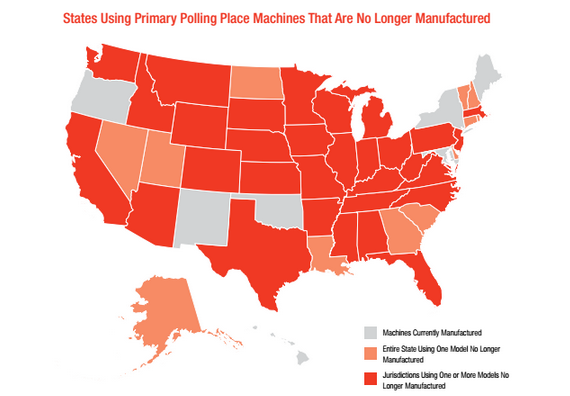WASHINGTON -- The experience of showing up at a polling place, only to discover that one or more of the voting machines are broken, is all too common for American voters. And episodes of election dysfunction are likely to become even more frequent as these machines reach and exceed their life expectancies.
A new report from Lawrence Norden and Christopher Famighetti of the Brennan Center for Justice at New York University highlights some alarming statistics regarding the nation's aging machines, which are supposed to be replaced every 10 to 15 years. In 2016, for example, 43 states will use machines that are at least a decade old. The researchers also found that election officials in more than 30 states want to buy new machines, but that officials in at least 22 of those states don't know where they would get the funds to do so.
"We’re at a point where these machines need to be replaced, but at the same time the message doesn’t seem to have gotten through to anybody who is responsible for funding the machines, and that’s what’s scary," said Norden, who is the deputy director of the center's Democracy Program.

Since machine failures or crashes usually lead to even longer lines at the polls -- and a study from the Massachusetts Institute of Technology estimated that as many as 750,000 voters left their polling place in 2012 because of lines -- the report's authors argue that replacing machines needs to be seen as a measure to shore up public confidence in elections. In Virginia, for instance, officials had to decertify a system used in 24 percent of the state's precincts because the machine's wireless features were found to be vulnerable to an external attack. Voters have also experienced problems with touch-screen technology, which led machines to record votes for a different candidate than the one selected.
Many of the machines in use today were bought with federal money from the Help America Vote Act, which former President George W. Bush signed two years after technologies like punch-card machines failed to accurately register Florida voters' ballots in the 2000 general election. HAVA also established the Election Assistance Commission to create guidelines for new voting technologies, but that body has become a casualty of partisan gridlock: It didn't have enough commissioners for a quorum from 2010 until December of 2014, and only has just started to function as it is meant to in the last few months.
There isn't any urgency at the federal level to provide new HAVA funding, and counties and states are caught in a blame game where each accuses the other of being responsible for purchasing new machines. Republican lawmakers in Virginia, for instance, characterized funding for new machines as a "local prerogative."
"We saw what happened when machines get old," Norden said. "They become unreliable, and when it’s a close election it’s literally a disaster. Unfortunately, people don’t pay attention to the machinery of our democracy until then."
Another problem, as the report details, is that many machines purchased at the turn of the century rely on outdated software for which there are no longer fixes available, or parts that are no longer manufactured. The report quotes a voting systems manager in Leon County, Florida, who was forced to surf eBay for an analog modem for his county's machines.
And a persistent economic disparity has arisen nationwide, as more well-off counties are able to purchase new and more reliable technologies while less well-off counties are stuck with malfunctioning equipment.
"We don’t ask the fire department to wait until the truck breaks down before they can think about a replacement cycle for machines," said Eduardo Cortes, the commissioner of Virginia's department of elections.
The report suggests that new funds go toward voting systems that are more modern and flexible. One idea is using commercial, off-the-shelf products, like an iPad or Android tablet, for voters to mark their ballots. Commercial printers could produce a paper ballot for review, and then voters could submit their ballot into a scanner. Such a system could provide savings for jurisdictions that are trapped in expensive vendor contracts for proprietary hardware. Larger, more well-off counties that host cities like Los Angeles and Austin, Texas, are experimenting with such systems, but these innovations could be copied elsewhere if the funds were available.
In the absence of new funds, the report urges the Election Assistance Commission to act as more of a clearinghouse for information about election technologies, so counties are aware of the problems other jurisdictions are facing.
